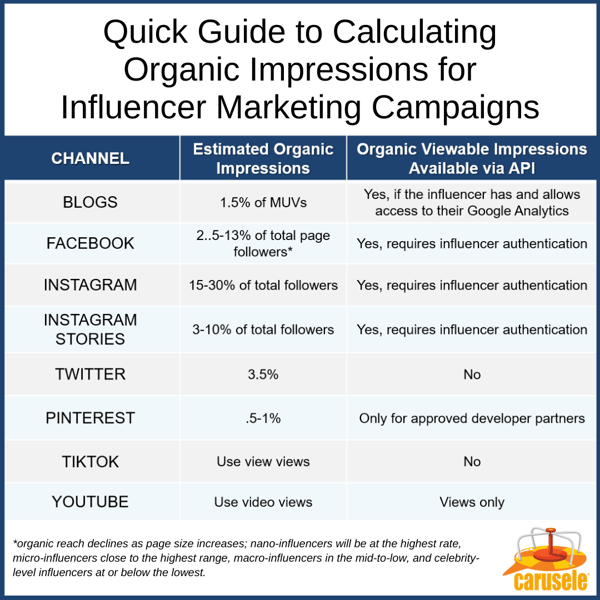HINT: Those INFLUENCER "Impressions" you're buying probably aren't real

Remember the good ol' days of social media marketing? The days when you tried hard to build a following on Facebook so you had another way (a free way) to talk to millions of loyal customers and hopefully convert some new ones? Remember back in 2013 when all your hopes and dreams came crashing down as Facebook organic reach declined, and then declined again?
As brands, we know that our posts to social media aren't reaching 100% of our followers on any channel these days. So why are brand marketers still accepting (often beating their chests to upper management, too) the fictional impression counts being reported by most influencer companies? I've heard a few reasons:- We can't get anything more accurate, at least it's apples to apples
- Upper management just wants to see a big number
- I can't justify the real CPM, so it's just easier this way
Well, folks -- this influencer marketing agency demands we be better marketers than that! So, we're calling for death to max potential reporting and the end to fictional metrics in the influencer industry. That's why, last year, we debuted a new metric for influencer marketing "Calculated True Views" to give Carusele clients a real indication of the impact their campaign had. Curious how your campaigns stack up? We built this handy influencer impressions calculator so you can see for yourself!
.png?width=728&name=Blog%20Ads%20(5).png)
Barrier 1: How to Measure Accurate Impressions for Influencer Campaigns
When I hear influencer marketing platforms tell me they can't get more accurate measures of impressions for influencer campaigns, I know right then and there it's time to end the call! Why? For many platforms, this data is available through the API and for the platforms where it's not available, there's plenty of published data sharing the latest organic reach percentages for the big social networks that can easily be used to estimate a reasonable real, viewable impressions number.
And, as a marketer who cares about the real impact of the programs I produce, I'd rather work off a data-informed best guess than a fictional, inflated impression number that assumes I reached 100% of the influencer's audience every time they posted. Don't have the technology at your fingertips to pull real numbers through the APIs?
Here's our simple formula for calculating organic impressions for an influencer campaign. This data uses published benchmarks where available and first-party data we've compiled manually from hundreds of brand and influencer social accounts.

We've run hundreds of campaigns, capturing organic impression data for posts by thousands of influencers and on average, we see ~9% of total potential reach delivering in actual, viewable impressions. To put it another way -- if an influencer company is reporting 20 million impressions from a campaign but those impressions are being calculated using the total follower count of the channel the influencer posted on, your campaign content was likely only even viewable 1.8 million times. And no, that's not 1.8 million in reach. That's 1.8 million impressions in the way a typical media company counts impressions. The "reach" or unique impressions is likely much lower than that as influencers often post multiple times on the same channel and have follower crossover on their multiple social accounts.
Barrier 2: Upper Management Wants to See a Big Number
Okay, fine. You've got to do what you've got to do. And if you're really stuck in this position, we use a metric called Equivalent Influencer Impressions to help brands see what a typical influencer company would have reported on our campaigns. (Hint: We're no "typical" influencer company :-))
Consider this: The reason upper management wants to see a big number is because they believe big numbers lead to big results, and in most cases, where those big numbers are real, that's true. BUT, when your big numbers are fiction, those results simply don't follow.
How do we get around it? Re-frame the conversation! Let's not talk about impressions at all. Impressions are easy to manufacture and easy to buy in any form of media. Results are not. So instead, let's focus on setting campaign goals that show whether the campaign actually impacted the people who saw it.
Awareness Objective? The reason marketers tend to accept a huge amount of impressions as an predictor of success is because they've likely see large volumes of impressions results in real business results. What's important though is that impressions do not equal sales or even consideration. In fact, research by Nielsen indicates that ad recall is the awareness metrics most strong correlated with brand awareness and consideration. Marketers often accept impressions counts as part of their media mix models because ad recall isn't readily available across every channel but, good news, if you are supporting your influencer content with ads across the Facebook network (hint; should be!) then you can easily get this metric for your campaigns.
Another helpful metric for awareness campaigns is attention. By calculate the attention (time spent) the campaign content received you can compare your spend (cost per minute of attention) to other awareness driving investments, like TV!
Consideration or Perception Building Objective? Look at engagement rates and click-through rate (calculated over organic reach, not those fictional max potential impressions, just like you do on brand own social channels); For e-commerce brands, try running a traffic optimized influencer campaign instead. You can see not only the real traffic driven to your website but also compare that traffic to other sources for quality indicators like time on site, bounce rate, adds to cart, and even purchases. Just be careful you're not comparing influencer to lower funnel sources like search traffic, it's rarely going to show you a good result and it's not apples to apples anyway.
Sales Objective? For brands that sell online, you can easily run a traffic driving campaign and set-up an attribution model that let's you estimate the real sales. (PLEASE don't fall into the trap of using last touch attribution, though, it won't work out in your favor.) For CPG brands and retailers, setting up a clean test and control (see this Tyson Tastemarkers Influencer campaign example) will let you run a sales analysis to determine the impact of your influencer campaign.
<< CONTINUE READING: How to Measure Influencer Marketing Effectiveness for eCommerce Brands >>
 Barrier 3: A "Good" CPM for Influencer Campaigns
Barrier 3: A "Good" CPM for Influencer Campaigns
It's crazy to me that the same brands who will pay a $35 CPM for a Super Bowl ad, guaranteed to either be a hit or a major flop and nothing in between, are dead set on paying CPMs in the $1-5 range for influencer marketing. A CPM that isn't even equivalent to a media buy because your COST also includes all the content creation, measurement, and agency fees! Know that if you are paying a CPM anywhere close to that low, that CPM is NOT being calculated off real impression counts.
Well, you get what you pay for, I suppose, but let's do more math, because I love math, using real numbers.
Let's say you spend $50K on an influencer campaign (That's all in cost!) and you get 25 million "impressions" and an easy to swallow $2 CPM. But now, let's do the math on the real impressions you got. Likely to come in more like 1-3 million impressions, depending which social channels you activated on. You've really paid somewhere between a $16 - $50 CPM. You just didn't know it.
Good news is, that "high" CPM you paid is getting you prime, in feed native placements with great targeting (assuming your influencer doesn't have fake followers) AND the cost used to calculate the CPM includes much more than just the cost to place the media.
Want to have some more fun with math? Check out our post on what goes into the cost of influencer posts!
Want to Learn More?
Let's chat about how our unique approach could work for your brand!
-1.png?width=504&height=360&name=Carusele%20logo%20%C2%AE%20logo%20Color%20(2)-1.png)
-1.png?width=728&name=Blog%20Ads%20(6)-1.png)
